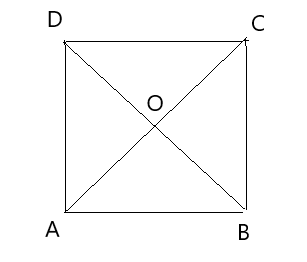
A quadrilateral whose diagonals are equal and bisect each other at right angles is called a:
Answer
527.4k+ views
Hint: In this question, we have to use the given property of quadrilateral and then prove any unique property of quadrilateral. So, we can easily identify the correct option.
Complete step-by-step answer:
Let us consider a quadrilateral ABCD in which the diagonals AC and BD intersect each other at o.

Given, the diagonals of ABCD are equal and bisect each other at right angles.
Therefore, AC = BD, OA = OC, OB = OD, and
Now, In
AO = CO (Diagonals bisect each other)
OB = OD (Diagonals bisect each other)
So,
Hence AB = CD (By CPCT) ...........(1)
And,
However, these are alternate interior angles for line AB and CD and alternate interior angles are equal to each other only when the two lines are parallel.
So,
From (1) and (2) equation,
ABCD is a parallelogram.
In
AO = CO (Diagonals bisect each other)
OD = OD (Common)
So,
Hence AD = DC ……….. (3)
However, AD = BC and AB = CD (Opposite sides of parallelogram ABCD)
So, AB = BC = CD = DA
Therefore, all the sides of quadrilateral ABCD are equal to each other.
In
AD = BC (Already proved)
AC = BD (Given)
CD = CD (Common)
So,
Hence,
However,
One of the interior angles of quadrilateral ABCD is a right angle.
Thus, we have obtained that ABCD is a parallelogram, AB = BC = CD = AD and one of its interior angles is
So, the correct option is (b).
Note: Whenever we face such types of problems we use some important points. Like first we prove that quadrilateral ABCD is a parallelogram and all sides of quadrilateral are equal then prove one of the interior angles of quadrilateral ABCD is a right angle. So, according to this property it is proved that the quadrilateral is Square.
Complete step-by-step answer:
Let us consider a quadrilateral ABCD in which the diagonals AC and BD intersect each other at o.

Given, the diagonals of ABCD are equal and bisect each other at right angles.
Therefore, AC = BD, OA = OC, OB = OD, and
Now, In
AO = CO (Diagonals bisect each other)
OB = OD (Diagonals bisect each other)
So,
Hence AB = CD (By CPCT) ...........(1)
And,
However, these are alternate interior angles for line AB and CD and alternate interior angles are equal to each other only when the two lines are parallel.
So,
From (1) and (2) equation,
ABCD is a parallelogram.
In
AO = CO (Diagonals bisect each other)
OD = OD (Common)
So,
Hence AD = DC ……….. (3)
However, AD = BC and AB = CD (Opposite sides of parallelogram ABCD)
So, AB = BC = CD = DA
Therefore, all the sides of quadrilateral ABCD are equal to each other.
In
AD = BC (Already proved)
AC = BD (Given)
CD = CD (Common)
So,
Hence,
However,
One of the interior angles of quadrilateral ABCD is a right angle.
Thus, we have obtained that ABCD is a parallelogram, AB = BC = CD = AD and one of its interior angles is
So, the correct option is (b).
Note: Whenever we face such types of problems we use some important points. Like first we prove that quadrilateral ABCD is a parallelogram and all sides of quadrilateral are equal then prove one of the interior angles of quadrilateral ABCD is a right angle. So, according to this property it is proved that the quadrilateral is Square.
Recently Updated Pages
Master Class 9 General Knowledge: Engaging Questions & Answers for Success

Master Class 9 English: Engaging Questions & Answers for Success

Master Class 9 Science: Engaging Questions & Answers for Success

Master Class 9 Social Science: Engaging Questions & Answers for Success

Master Class 9 Maths: Engaging Questions & Answers for Success

Class 9 Question and Answer - Your Ultimate Solutions Guide

Trending doubts
How many ounces are in 500 mL class 8 maths CBSE

Summary of the poem Where the Mind is Without Fear class 8 english CBSE

Advantages and disadvantages of science

10 slogans on organ donation class 8 english CBSE

In Indian rupees 1 trillion is equal to how many c class 8 maths CBSE

How many ten lakhs are in one crore-class-8-maths-CBSE




